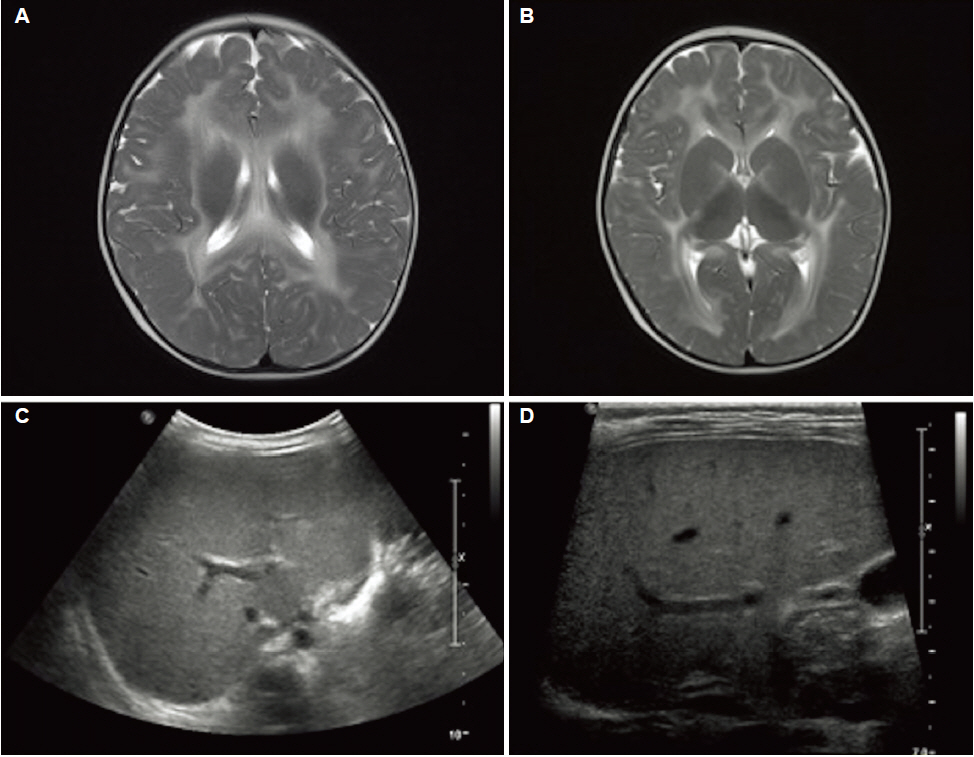Korean J Gastroenterol.
2021 May;77(5):248-252. 10.4166/kjg.2020.170.
MPV17-related Hepatocerebral Mitochondrial DNA Depletion Syndrome
- Affiliations
-
- 1Department of Pediatrics, Seoul National University College of Medicine, Seoul, Korea
- KMID: 2516042
- DOI: http://doi.org/10.4166/kjg.2020.170
Abstract
- Mitochondrial DNA (mtDNA) depletion syndrome comprises diseases resulting from a deficiency of proteins involved in mtDNA synthesis. MPV17 is a mitochondrial membrane protein whose mutation causes mitochondrial deoxynucleotide insufficiency. MPV17-related hepatocerebral mtDNA depletion syndrome is a rare autosomal recessive disease. This case report describes the clinical manifestations of MPV17-related hepatocerebral mtDNA depletion syndrome analyzed by performing whole-exome sequencing (WES). A 17-month-old girl presented with developmental delay, jaundice, and failure to thrive. The laboratory findings revealed cholestatic hepatitis, increased lactate-to-pyruvate ratio, and prolongation of the prothrombin time. She developed a hypoglycemic seizure. Brain magnetic resonance imaging revealed extensive demyelination of the white matter. WES detected the p.Leu151fs and p.Pro98Leu variants in MPV17. Her parents and sibling were found to be MPV17 heterozygous carriers. She was administered supportive treatment, such as replacement of fat-soluble vitamins and cornstarch to prevent further hypoglycemic events. The patient is currently being considered for liver transplantation. Overall, WES can help diagnose hepatocerebral mtDNA depletion syndrome in patients with hepatopathy, developmental delay, lactic acidosis, and hypomyelination based on brain magnetic resonance imaging.
Keyword
Figure
Reference
-
1. El-Hattab AW, Craigen WJ, Scaglia F. 2017; Mitochondrial DNA maintenance defects. Biochim Biophys Acta Mol Basis Dis. 1863:1539–1555. DOI: 10.1016/j.bbadis.2017.02.017. PMID: 28215579.
Article2. El-Hattab AW, Craigen WJ, Wong LJC, Scaglia F. 2018. Mitochondrial DNA maintenance defects overview. University of Washington;Seattle:3. Dalla Rosa I, Cámara Y, Durigon R, et al. 2016; MPV17 loss causes deoxynucleotide insufficiency and slow DNA replication in mitochondria. PLoS Genet. 12:e1005779. DOI: 10.1371/journal.pgen.1005779. PMID: 26760297. PMCID: PMC4711891.
Article4. Spinazzola A, Viscomi C, Fernandez-Vizarra E, et al. 2006; MPV17 encodes an inner mitochondrial membrane protein and is mutated in infantile hepatic mitochondrial DNA depletion. Nat Genet. 38:570–575. DOI: 10.1038/ng1765. PMID: 16582910.
Article5. El-Hattab AW, Wang J, Dai H, et al. 2018; MPV17-related mitochondrial DNA maintenance defect: new cases and review of clinical, biochemical, and molecular aspects. Hum Mutat. 39:461–470. DOI: 10.1002/humu.23387. PMID: 29282788.
Article6. Merkle AN, Nascene DR, McKinney AM. 2012; MR imaging findings in the reticular formation in siblings with MPV17-related mitochondrial depletion syndrome. AJNR Am J Neuroradiol. 33:E34–E35. DOI: 10.3174/ajnr.A2455. PMID: 21511859. PMCID: PMC7966431.7. Kim J, Kang E, Kim Y, et al. 2016; MPV17 mutations in patients with hepatocerebral mitochondrial DNA depletion syndrome. Mol Genet Metab Rep. 8:74–76. DOI: 10.1016/j.ymgmr.2016.06.006. PMID: 27536553. PMCID: PMC4976613.
Article8. Choi M, Scholl UI, Ji W, et al. 2009; Genetic diagnosis by whole exome capture and massively parallel DNA sequencing. Proc Natl Acad Sci U S A. 106:19096–19101. DOI: 10.1073/pnas.0910672106. PMID: 19861545. PMCID: PMC2768590.
Article9. Ng SB, Turner EH, Robertson PD, et al. 2009; Targeted capture and massively parallel sequencing of 12 human exomes. Nature. 461:272–276. DOI: 10.1038/nature08250. PMID: 19684571. PMCID: PMC2844771.
Article10. Yang Y, Muzny DM, Reid JG, et al. 2013; Clinical whole-exome sequencing for the diagnosis of mendelian disorders. N Engl J Med. 369:1502–1511. DOI: 10.1056/NEJMoa1306555. PMID: 24088041. PMCID: PMC4211433.
Article11. Jacob HJ, Abrams K, Bick DP, et al. 2013; Genomics in clinical practice: lessons from the front lines. Sci Transl Med. 5:194cm5. DOI: 10.1126/scitranslmed.3006468. PMID: 23863829.
Article12. Shimura M, Kuranobu N, Ogawa-Tominaga M, et al. 2020; Clinical and molecular basis of hepatocerebral mitochondrial DNA depletion syndrome in Japan: evaluation of outcomes after liver transplantation. Orphanet J Rare Dis. 15:169. DOI: 10.1186/s13023-020-01441-5. PMID: 32703289. PMCID: PMC7379809.
Article13. Choi YR, Hong YB, Jung SC, et al. 2015; A novel homozygous MPV17 mutation in two families with axonal sensorimotor polyneuropathy. BMC Neurol. 15:179. DOI: 10.1186/s12883-015-0430-1. PMID: 26437932. PMCID: PMC4595119.
Article14. El-Hattab AW, Wang J, Dai H, et al. 2012. MPV17-related mitochondrial DNA maintenance defect. University of Washington;Seattle:
- Full Text Links
- Actions
-
Cited
- CITED
-
- Close
- Share
- Similar articles
-
- Depletion of Mitochondrial DNA Stabilizes C1qTNF-Related Protein 6 mRNA in Muscle Cells
- A Case of Early Onset MELAS Patient with Wolff-Parkinson-White Syndrome
- MELAS Syndrome Confirmed by Mitochondrial DNA Analysis in Siblings
- Analysis of Nuclear Mitochondrial DNA Segments of Nine Plant Species: Size, Distribution, and Insertion Loci
- Analysis of Mitochondrial DNA in Patients with Essential Tremor




